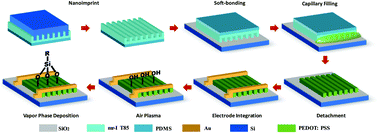A chemiresistive sensor array from conductive polymer nanowires fabricated by nanoscale soft lithography†
Abstract
One-dimensional organic nanostructures are essential building blocks for high performance gas sensors. Constructing an e-nose type sensor array is the current golden standard in developing portable systems for the detection of gas mixtures. However, facile fabrication of nanoscale sensor arrays is still challenging due to the high cost of the conventional nanofabrication techniques. In this work, we fabricate a chemiresistive gas sensor array composed of well-ordered sub-100 nm wide conducting polymer nanowires using cost-effective nanoscale soft lithography. Poly(3,4-ethylene-dioxythiophene)-poly(styrene sulfonate) (PEDOT:PSS) nanowires functionalized with different self-assembled monolayers (SAMs) are capable of identifying volatile organic compounds (VOCs) at a low concentration range. The side chains and functional groups of the SAMs introduce different sensitivities and selectivities to the targeted analytes. The distinct response pattern of each chemical is subjected to pattern recognition protocols, which leads to a clear separation towards ten VOCs, including ketones, alcohols, alkanes, aromatics and amines. These results of the chemiresistive gas sensor array demonstrate that nanoscale soft lithography is a reliable approach for fabricating nanoscale devices and has the potential of mass producibility.



 Please wait while we load your content...
Please wait while we load your content...